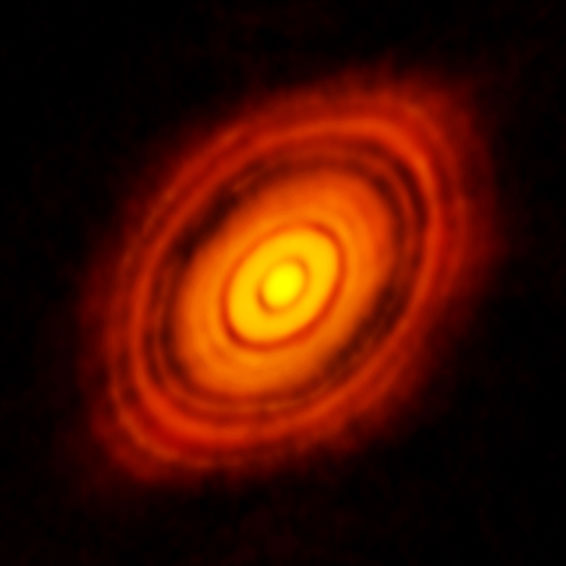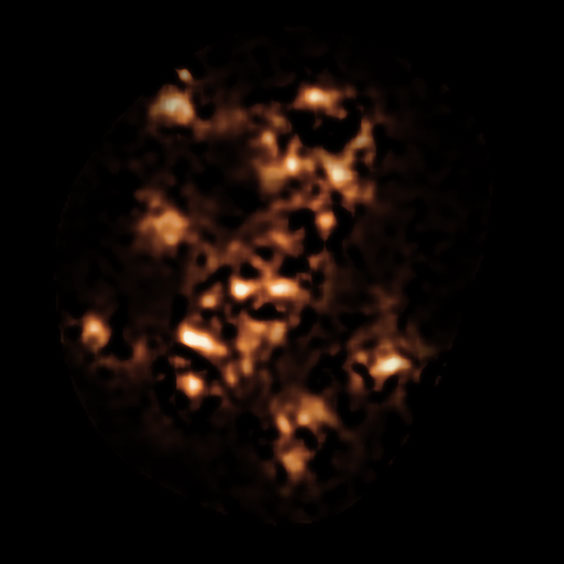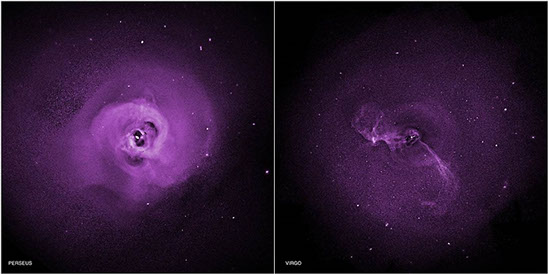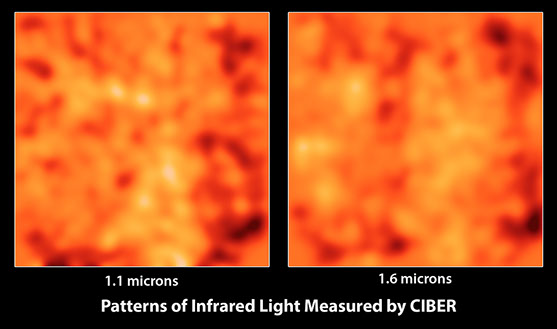

November 2014
Solar System Formation Imaged
The finest detail ever imaged of a planet-forming disc around a young star has been obtained by ALMA, the Atacama Large Millimeter/Submillimeter Array in Chile. Made at submillimeter wavelengths, these images are sharper than the optical images obtained by the Hubble Space Telescope. Optical cameras cannot see through the envelope of dust that surrounds the disc. Optical cameras, such as the one on Hubble, see what the human eye sees. ALMA 'sees' using longer submillimeter wavelengths that can image right to the core of the cloud. The star is HL Tauri, located about 450 light-years away in the constellation Taurus.
A star is formed out of a concentration of gas, mainly Hydrogen, in space. Once the star forms, its gravity shapes the remaining dust and gas forms into a disc surrounding the new star. This is called a protoplanetary disc. The dust particles then collide with each other and form the planets, comets, asteroids and moons that make up a solar system.
The protoplanetary disc around HL Tauri is what ALMA imaged. Looking at the photograph you see dark rings along with gaps. These are caused by the formation of planets. Eventually, the dust and gases form complete planets. This disc around HL Tauri is how the disc around our sun would have looked when the Earth was being formed over four billion years ago.
Based on this photo, new theories are being developed concerning the formation of a solar system. For instance, HL Tauri is only about a million years old. It was always theorized that planet formation could not take place this quickly after the formation of the star. But this photo now must rewrite that theory.
The high resolution images that can be obtained by ALMA will allow scientists to learn more about the formation of planets in the Universe as well as how the Earth itself formed.

Image Credit: ESO
Spiderweb Galaxy
Astronomers have been looking deep into the Spiderweb Galaxy using the APEX telescope in Chile. Observing submillimeter wavelenghs they were able to peer through the dust and for the first time take a full census of star formation in the Spiderweb.
The Spiderweb is actually a cluster of galaxies in the process of merging together. Located about 10 billion light years away, we are looking at galaxies how they appeared only a few billion years after the Big Bang. Originally detected by radio, there is a supermassive black hole at the center. The Hubble Space Telescope detected dozens of galaxies caught in what is described as a web of gravity that is pulling them in. Thus the name Spiderweb.
Looking at the submillimeter wavelengths, scientists are able to see the galaxy cluster in much more detail. It was observed that there are about four times as many sources of star formation in the area of the Spiderweb compared to the surrounding sky. What came as a surprise and has opened a new mystery is that instead of star formation taking place on the large filaments of connecting galaxies, it was located in a single region not in the center of the galaxy cluster. This may mean that the mega galaxy being formed is developing asymmetrically.
Further observations will now be needed. Turning to ALMA they should be able to resolve these areas in even finer detail.

This photo is from APEX and shows the Spiderweb in submillimeter light. The bright blobs are star forming areas.
Credit: ESO
Visit our sponsors.


For advertising opportunities on this page and our videos, contact
Upcoming Launches
Date: November 23
Launch Vehicle: Soyuz
Launch Site: Baikonur Cosmodrome, Kazakhstan
Description: Soyuz 41 to take Terry Virts, Samantha Cristoforetti and Anton Shkaplerov to the International Space Station
Exo-Comets
In addition to studying planets orbiting other stars, scientists are now able to study comets orbiting other stars. Using the HARPS instrument on the ESO 3.6 metre telescope at the La Silla Observatory in Chile, scientists have been looking at the star Bets Pictoris. Beta Pictoris is located 63 light-years from Earth and is a young star at only 20 million years old. The star is surrounded by a large protoplanetary disc.
Subtle changes in light from Beta Pictoris is caused by the passage of comets in front of the star. The star is so bright compared to the comets themselves that imaging the comets is impossible. So scientists 'observe' the comets by the light changes of the star.
There are two different families of comets around Beta Pictoris. Old exo-comets have orbited the star many times and their ices are beginning to evaporate. Young exo-comets seem to have been recently developed out of collisions of larger objects.
These studies lead to insight on comet production in the early formation of a solar system, much like our sun was 4.5 billion years ago.
Turbulence Preventing Star Birth
Galaxy clusters are a large number of galaxies held together by gravity. Surrounding the individual galaxies is hot gas. As the hot gas cools, star formation begins. But in these galaxy clusters the gases do not cool as expected, thus preventing star formation.
NASA's Chandra X-ray space telescope may now shed some light on the situation. The answer may be turbulence.
Supermassive black holes exist in large galaxies in the middle of the galaxy clusters. These black holes throw out vast amounts of energy as objects are sucked in. The energy creates cavities in the hot gases. This interaction creates turbulence. The turbulence then can keep the gases hot for billions of years. As long as the black hole continues to release energy, the turbulence is created keeping the gas hot. As the black hole runs out of objects to suck in, the energy release stops, and in turn the turbulence stops allowing the gas to cool and star formation to begin.

Perseus and Virgo Clusters observed in X-ray by Chandra
Credit: NASA/CXC/Stanford/I. Zhuravieva et al
Future New Horizons Targets
The Hubble Space Telescope has been assisting in trying for find some targets for New Horizons to visit after its flyby of Pluto next year. Hubble has identified three Kuiper Belt Objects (KBOs) that are potential targets.
The objects are about 10 times larger than typical comets and only about 1 to 2 percent the size of Pluto. They range from about 34 miles (55 km) to 15 miles (25 km) across. As they reside in the Kuiper Belt they have never flown into the inner solar system so they remain icy frozen well preserved samples of the early solar system. They are located about a billion miles farther out than Pluto. It would take New Horizons another three or four years to reach them.
New Horizons will arrive at Pluto in July 2015. A proposal would then be put forward in late 2016 to extend the mission.
Stars Outside Galaxies
NASA's Cosmic Infrared Background Experiment (CIBER) has detected a vast amount of infrared light in space between galaxies. This cosmic glow is as bright as all known galaxies combined. The glow is thought be from stars that have been flung out into space.
When galaxies interact and merge it seems that many stars are flung out of the galaxies. The infrared glow detected by CIBER has a blue spectrum. Light from the first galaxies give off a redder spectrum. The explanation for this is the blue spectrum glow is from stars thrown out of the early galaxies as they formed and merged in the early Universe.
The CIBER team is working on instruments with better measurements so they can begin testing this theory. CIBER is launched on sub-orbital sounding rockets.

CIBER images after all known galaxies have been subtracted out. Result is the light in the Universe not from galaxies.
Credit: NASA/JPL-CalTech
© 2014-2016 Ted Cook Productions LLC. - All Rights Reserved